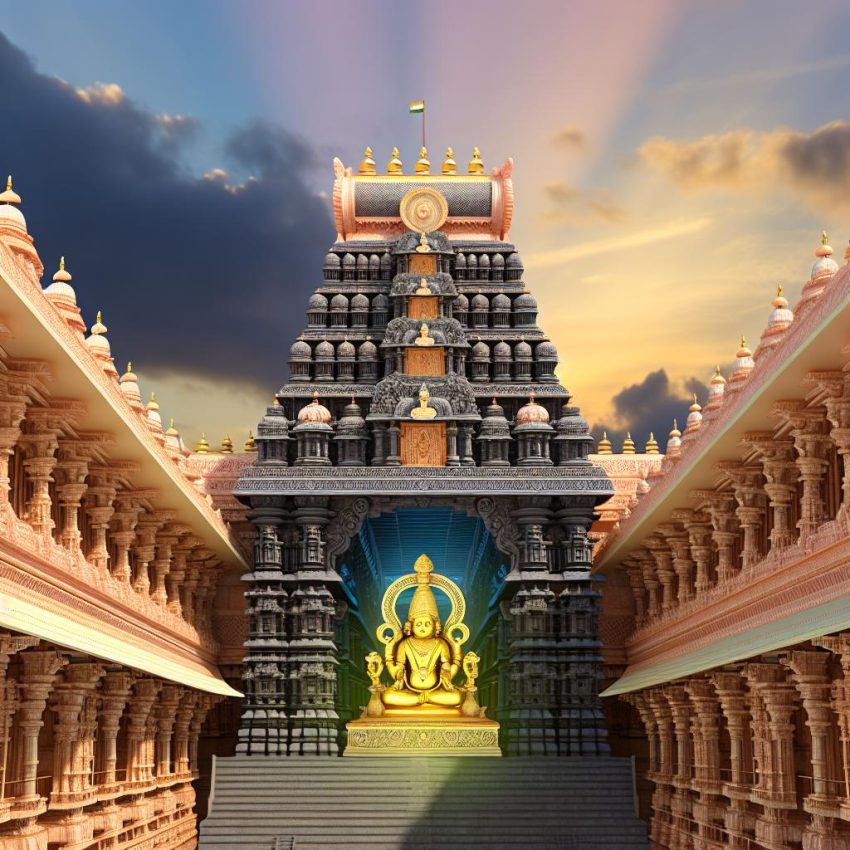Introduction
The Udupi Sri Krishna Temple, located in the picturesque coastal town of Udupi in the Indian state of Karnataka, represents a significant pilgrimage site revered for its profound religious importance. This temple is dedicated to Lord Krishna and is renowned for its unique rituals, rich history, and captivating architecture. Additionally, Udupi Sri Krishna Temple serves as a major center for Dvaita Vedanta philosophy, a school of thought expounded by the eminent saint Madhvacharya in the 13th century. The temple not only stands as a testament to spiritual faith but also reflects cultural traditions that have been preserved and respected through centuries.
Historical Background
The foundation of the Udupi Sri Krishna Temple is attributed to the Vaishnavite saint Madhvacharya, who was instrumental in establishing the Dvaita Vedanta school of Hindu philosophy. According to local legends, Madhvacharya discovered the idol of Lord Krishna, which is enshrined in the temple today, ensconced within a large ball of gopi sandalwood. This miraculous find is central to the temple’s history and legacy. Interestingly, the statue of Lord Krishna is installed facing west, a peculiar feature as it deviates from the traditional architectural norms of temple construction in South India, where deities typically face east. This unique orientation adds to the divine aura and mystery associated with the temple.
Architecture
The architecture of Udupi Sri Krishna Temple exemplifies typical Dravidian style, incorporating distinctive elements that set it apart from other religious structures in the region. The core of the temple is the garbhagriha, or sanctum sanctorum, which houses the central idol of Lord Krishna. This idol is lavishly adorned with jewels and finery, and devotees can view the idol through a specially crafted silver-plated window known as the KanaKana Kindi. The temple complex also includes several shrines, a large courtyard, and a sacred pond, all harmoniously integrated to create an atmosphere of divine serenity and mystical charm.
Significant Rituals and Practices
Ritualistic observances at the Udupi Sri Krishna Temple are governed by the Tantrasara liturgical tradition, which places a strong emphasis on daily worship and vibrant festival celebrations. One of the temple’s most prominent observances is the Ashtami Rohini, which marks the birthday of Lord Krishna and is celebrated with tremendous enthusiasm and devotion by throngs of devotees. A distinctive feature of the temple’s administration is the management practice by the Palimaru Mutt, which is rotated every two years among eight different mathas or religious monasteries. This practice of rotational management has historical roots tracing back to the arrangements set by Madhvacharya, showcasing an enduring tradition that blends administrative efficiency with spiritual stewardship.
Main Festivals
Udupi Sri Krishna Temple is the epicenter of several significant festivals that draw both local and international devotees. Key celebrations include Krishna Janmashtami, which commemorates the birth of Lord Krishna, Makara Sankranti, which celebrates the sun’s transition into the zodiac sign of Capricorn, and the Paryaya festival. The Paryaya festival, held biennially, signifies the transfer of temple management from one matha to another. During this event, the chosen monk symbolically assumes the responsibility of temple operations, maintaining a tradition that ensures continual engagement with the community and continuity of temple services. These festivals are not only religious events but also cultural spectacles offering insight into the rich tapestry of regional traditions and spiritual fervor.
Community and Cultural Impact
The Udupi Sri Krishna Temple plays a pivotal role in shaping the social and cultural dynamics of Udupi and its surrounding areas. It draws thousands of pilgrims and tourists each year, significantly contributing to the local economy while fostering a spirit of cultural tourism. Moreover, the temple is integral to the preservation and promotion of Yakshagana, a classical musical art form that combines dance, music, and drama to convey religious stories and moral lessons. By supporting and showcasing these cultural expressions, the temple acts as a custodian of India’s vast artistic heritage, ensuring that future generations continue to connect with and appreciate the depth of their ancestral culture.
Conclusion
The Udupi Sri Krishna Temple stands as an embodiment of India’s spiritual depth and cultural richness. Its distinctive traditions, rituals, and festivals provide an unparalleled window into centuries-old religious practices that continue to inspire devotion and curiosity among visitors from around the world. As a landmark of historical, architectural, and cultural significance, the temple invites all to explore its sacred halls and partake in its vibrant legacy. For those interested in delving deeper, engaging with official resources and planning a visit can offer an enriching experience that reveals the extraordinary character of this hallowed site. Through ongoing engagement and preservation efforts, the Udupi Sri Krishna Temple remains a beacon of faith and cultural heritage, connecting the past with the present and inspiring future generations.
